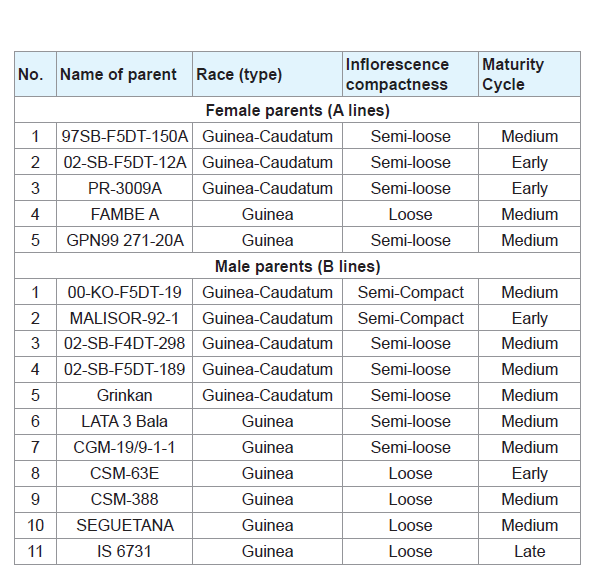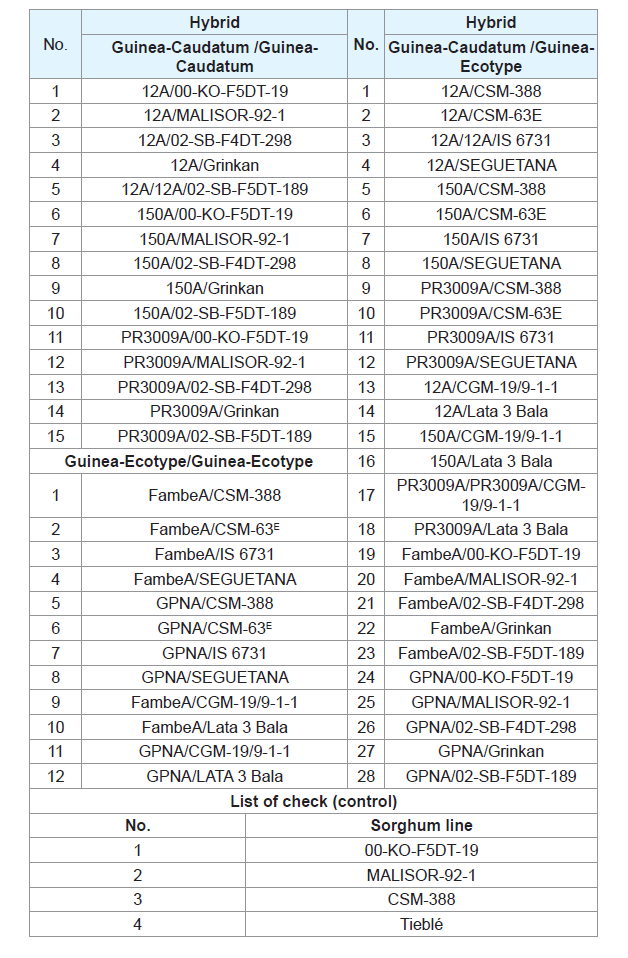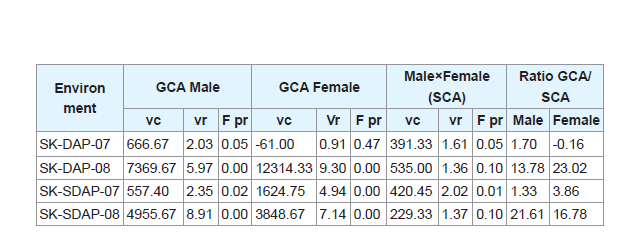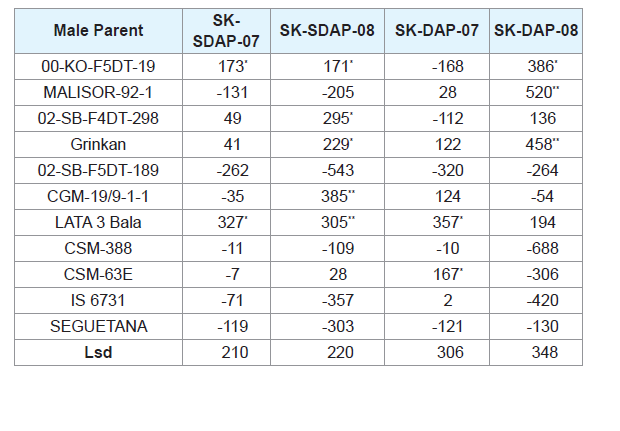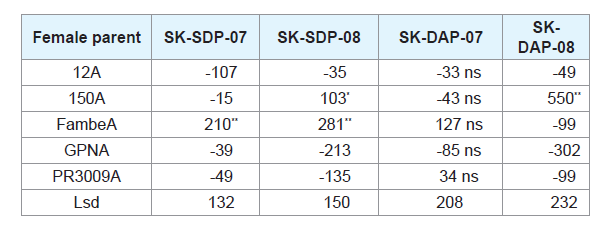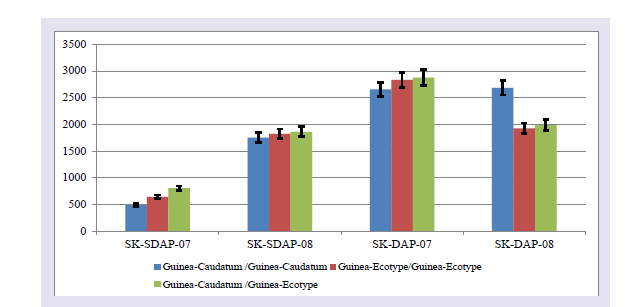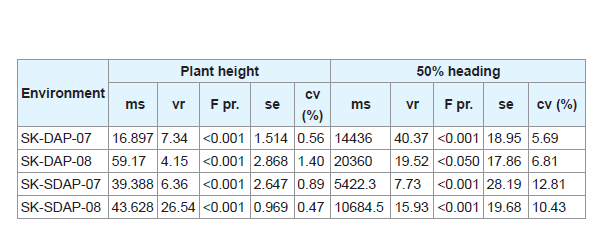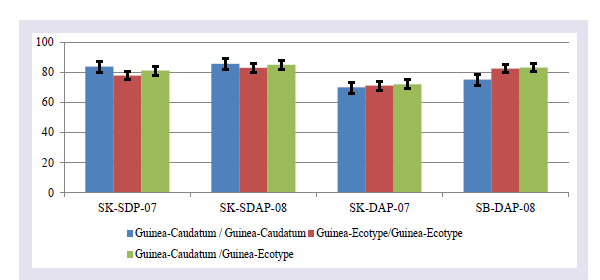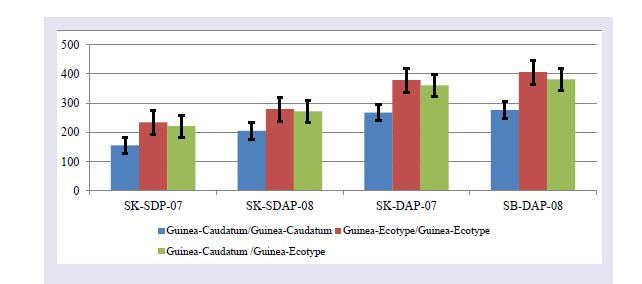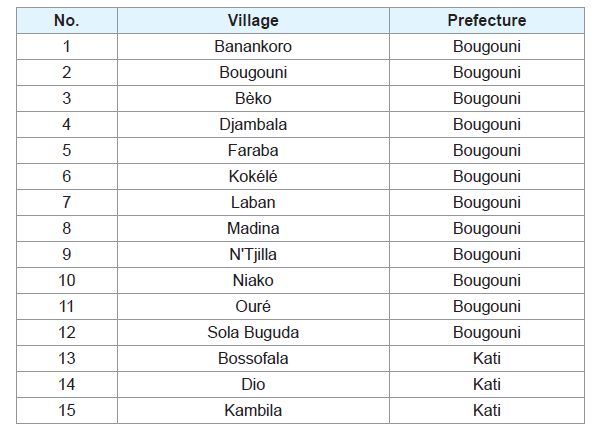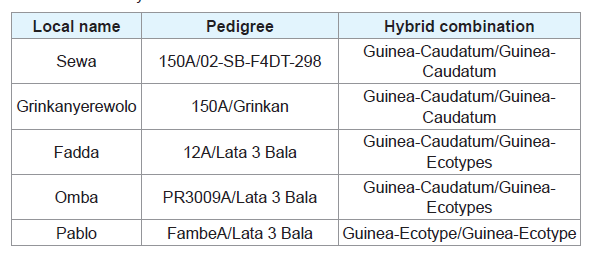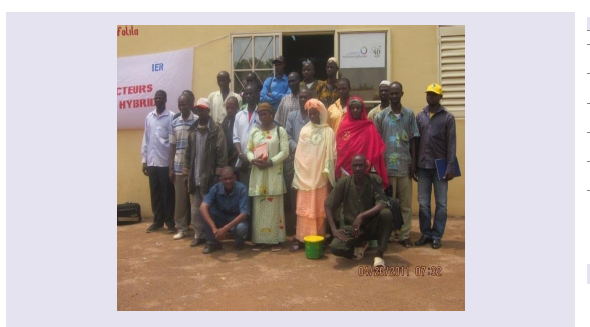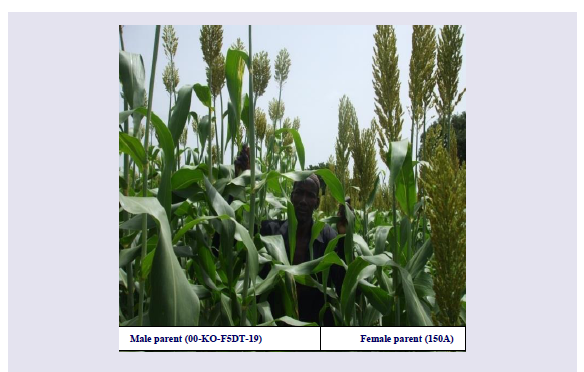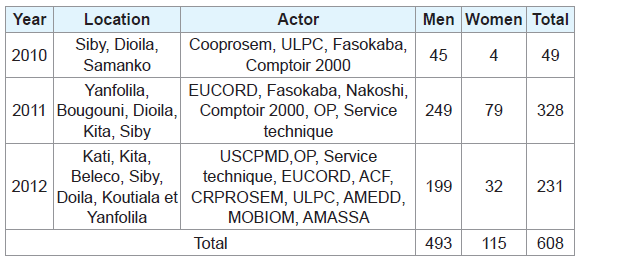Journal of Plant Biology & Soil Health
Download PDF






Research Article
Agronomic Performances of Hybrid Sorghum bicolor [L] Moench, Guinea Races Cultivated under Limited and High-Soil Phosphorus Conditions
Abdoulaye Gaoussou Diallo1*, Sissoko Sory1,2, Aboubacar Oumar Touré1, Foutoumata Toure2, Aboubacar Touré3 and Frederick Weltzien Rattunde3
- 1Centre Régional de Recherche Agronomique (CRRA) de Sotub, Institut d’Economie Rurale (IER) Mali, Africa
- 2Faculté des Sciences et Techniques, Universite des Sciences des Techniques et des Technologies de Bamoko (USTTB), Mali, Africa
- 3International Crops Research Institute for the Semi-Arid Tropics (ICRISAT)
*Address for Correspondence: Abdoulaye Gaoussou Diallo, Centre Régional de Recherche Agronomique (CRRA) de Sotub, Institut d’Economie Rurale (IER), Rue Mohamed V, BP 258, Bamako, Mali, Africa, Tel: (+223) 20222606/20231905. Fax: (+223) 20223775; E-mail: ag_diallo@hotmail.com
Citation: Diallo AG, Sory S, Touré AO, Toure F, Touré A. et al. Agronomic Performances of Hybrid Sorghum bicolor [L] Moench, Guinea Races Cultivatedunder Limited and High-Soil Phosphorus Conditions. J Plant Biol Soil Health. 2017;4(2): 8.
Copyright: © 2017 Diallo AG, et al. This is an open access article distributed under the Creative Commons Attribution License, which permits unrestricted use, distribution, and reproduction in any medium, provided the original work is properly cited.
Journal of Plant Biology & Soil Health | ISSN: 2331-8996 | Volume: 4, Issue: 2
Submission: 21 September, 2017 | Accepted: 02 November, 2017 | Published: 11 November, 2017
Keywords
Sorghum; Hybrids; Combining ability; Phosphorus
Abstract
Sorghum bicolor [L] Moench is among the main starchy staples in Mali. However, its yield is low. Development of Guinea sorghum hybrids adapted to the Malian environment is one of the solutions to increase sorghum production and productivity. This study was carried out to: identify the combining ability of Guinea sorghum and intermediate races for grain yield, to assess the agronomic performance of hybrids in relation to local cultivars currently grown by the farmers under low and high soil phosphorus conditions; and develop the methods of hybrid seed production. Study was conducted in research stations of Samanko during the rainy season. Results revealed that the response of yield and plant growth performance to fertilization depended on the genotype. The Guinea-Caudatum/Guinea-Caudatum hybrids were the most productive in the plot with Di-Ammonium Phosphate (DAP). On the other hand, in the poor soil without DAP the Guinea-Ecotype/Guinea-Ecotype and Guinea-Ecotype/Guinea-Caudatum hybrids were the most productive. The best hybrids in terms of high yield stability in both trials were evaluated in farmers’ fields in 15 villages. The hybrids: 150A/02-SB-F4DT-298, 150A/Grinkan, 12A/Lata-3-Bala, PR3009A/Lata-3-Bala and FambeA/Lata-3-Bala were identified as the farmers’ preferred hybrids due to their high yield and good grain quality, and they were listed in the National Catalog. A total of 608 seed production farmers and peoples from private seed companies, farmers' associations and extension services were trained in hybrid seed production techniques. Through this study, the introduction of sorghum hybrids farming in Mali has become a reality.
Introduction
Sorghum (Sorghum bicolor [L] Moench) is the fifth most important cereal crop in the world after wheat, maize, rice, and barley [1]. It is the dietary staple of more than 500 million people in more than 30 countries and is grown on 42 million hectares in 98 countries of Africa, Asia, Oceania and America [1]. Nigeria, India, USA, Mexico, Sudan, China and Argentina are its major producers. In Africa, sorghum ranks the second after maize (Zea mays) in terms of production and consumption with significant producing countries being Nigeria, Mauritania, Gambia, Mali, Burkina Faso, Ghana, Niger, Somalia, Chad, Tanzania and Mozambique [1]. There are 20-30 species of sorghum. Harlan JR et al. proposed a simplified classification scheme of cultivated sorghums based on morphological characteristics that most present-day breeders have come to recognize and utilize and partitioned the primary gene pool, Sorghum bicolor (L.) Moench into five major races: Bicolor, Guinea, Caudatum, Kafir, and Durra and ten intermediate races or all combinations of the basic races [2].
The five basic races are:
•Bicolor: The most primitive cultivated sorghum, characterized by open inflorescences and long clasping glumes that enclose the usually small grain at maturity.
•Caudatum: Characterized by turtle-backed grains that is flat on one side and curved on the other; the panicle shape is variable and the glumes are usually much shorter than the grain.
•Durra: Characterized by compact inflorescences, characteristically flattened sessile spikelets, and creased lower glumes; the grain is often spherical.
•Guinea: Characterized by usually large, open inflorescences with branches often pendulous at maturity; the grain is typically flattened and twisted obliquely between long gaping glumes at maturity.
•Kafir: Characterized by relatively compact panicles that are often cylindrical in shape, elliptical sessile spikelets and tightly clasping glumes that are usually much shorter than the grain. Many subgroups can be distinguished with cultivars especially adapted to high or low rainfall regimes.
In Mali, sorghum is among the major crops along with pearl millet, rice, maize, cotton, peanut, and cowpea. Production of sorghum, however, does not meet demand of the growing population in the country. Grain sorghum yields are very low (0.8 to 1.3 tons/ha) and these yields are well below the genetic potential of sorghum, which, under favorable conditions, can yield up to 13 tons/ha [3]. Toure S indicated that three major sorghum races exist in Mali: Guinea, Durra and Caudatum [4]. The Guinea sorghums constitute the dominant race grown by farmers and represent about 70% of sorghum races in Mali. They are well known for their high grain quality, good weathering, pest resistance, and storage qualities [5]. However, the yield potential of most cultivars is relatively low.
The sorghum production is decreasing due to several reasons including low soil fertility, high cost of input, drought, low adoption of improved cultivars and lack of sorghum hybrids.
Phosphorus (P) deficiency ranks second in importance after nitrogen (N) deficiency in sorghum-growing regions of the semi-arid tropics Africa [6]. Amelioration of phosphorus (P) deficiency by application of P fertilizers is costly for the small subsistence farmers with limited financial resources. They need to determine efficient fertilizer practices in conjunction with the development of P-efficient cultivars.
The adoption of improved cultivars from sorghum breeding programs is very low, less than 5% of the cultivated area [7,8]. This is due the poor adaptation of the available cultivars to the farmers’ environments, the poor food quality, poor storability of grain and the lack of information on the existence and utility of new cultivars [9].
The adoption of hybrid sorghum is also very low by Malian sorghum producers. In Mali the exploitation of hybrid sorghum began in 1979 and between 1986 and 1990 the initial hybrid materials were lost from the Malian sorghum; hence it needs to develop new parents and high yielding hybrids [10].
Objectives
General objective
Increase production and productivity of sorghum in Mali.
Specific objectives
To identify the combining ability of parents of different groups of Guinea sorghum races and Guinea intermediate races for grain yield and others agronomic traits under limited and high-phosphorus conditions.To evaluate the agronomic performance of hybrids with check in trials without phosphorus (-P) and trials with phosphorus fertilization (+P)
To evaluate the agronomic performance of hybrids with check in trials without phosphorus (-P) and trials with phosphorus fertilization (+P).
To develop and promote parents and hybrids of sorghum Guinea races and Guinea intermediate races in limited and high phosphorus conditions.
Materials
Experimental site
The Agricultural Research Station of Samanko, IER Mali is located at the West of the town of Bamako on the road of Kangaba. The climate is of Sudano Sahelian type. Coordinates are 12°54' North, 8°4' West on altitude 329 m and isohyet between 800 and 1000 mm. The soil is clay loam or sandy clay with very poor nutrients.
Plant material
Five female parents (cms) and eleven fertile male parents developed in Mali were selected for study (Table 1). The combination of female and male parents generated 55 hybrids, including 12 Guinea-ecotype×Guinea-ecotype, 15 Guinea-Caudatum×Guinea-Caudatum and 28 Guinea-Caudatum×Guinea-ecotype (Table 2). These hybrids were planted with four sorghum lines used as checks (Table 2). One cultivar of maize (Sotubaka) was used to supplement the total number of material at 60 genotypes. The performance of this maize cultivar was not measured in the study.
Methods
The research was conducted in 2007 and 2008 respectively at Samanko Research Station in one trial with Di-ammonium phosphate (DAP) applied and the other without phosphorus applied each year. A total of four trials were conducted (Table 3).
Experimental design
The experimental design was alpha-lattice with three replicates [(10×6)×3] for each trial. Each genotype was sown in four rows of three meters length. The spacing between rows was 0.75 m, and between hills within a row was 0.40 m (eight hills per row). Five to six seeds of genotypes were planted in each hole and thinned to two plants per hill at three weeks after emergence to give a population density of 16 plants per row either 71,111 plants per hectare.
The field management
•Soil preparation: For plowing and ridging the tractor was used, the plow was used for the butting.
•Soil preparation: For plowing and ridging the tractor was used, the plow was used for the butting.
•Fertilization: The Di-ammonium phosphate (DAP 18-46-0) was applied to the dose of 100 kg/ha at the sowing time in the phosphorus trials in 2007 and 2008. Other two trials (without phosphorus) did not receive phosphorus in (2007 and 2008) but to supply nitrogen, these trials received 37 kg/ha nitrogen at the sowing time. And then nitrogen was also applied to all trials at 50 kg/ha at first weeding for the two years.
Data collection
•Plant height: The plant height was recorded by measuring the distance from ground level to the tip of the panicle at physiological maturity and expressed in centimeters.
•Days to 50% heading: It was recorded as number of days from the date of sowing to the date when half (50%) of the plants in the plot have visible heads.
•Grain yield (kg/ha): The grain yield was computed as:

where,
GY = Grain yield (kg/ha)
GYP = Grain yield per plot (kg)
PA = Plot Area (ha)
Data analysis
Combining ability analysis of hybrids’ parents
The ANOVA of General Combining Ability (GCA) and Specific Combining Ability (SCA) were estimated for each environment using the regression method.
•Model for each environment:

Where,
Y = Regression model
R = Number of Repetitions
R/B = Repetitions and Blocks
M = Males
F = Females
M * F = Males and Females interaction
In order to assess the effect of the Genotype*Environment interaction on combining ability, a combined analysis was performed using the regression method.
•Model for across environments

Where,
Y = Regression model
E = Environment
E/R/B = Environment, Repetitions and Blocks
M = Males
F = Females
E * M = Environment-Males interaction
E * F = Interaction-Environment Females
M * F = Male-Female Interaction
E * M * F = Environment-Male-Female interaction
•Estimation of GCA and SCA effects
GCA was computed as:

and

Where,
Xf and Xm = Mean of female and male respectively
GCAf and GCAm = General combining ability of female and male respectively. μ = Overall mean of crosses in the trial.
SCA was computed as:

Xi = Observed mean value of the cross
Ej = Expected mean value of the cross based on the 2 GCAs of its parents
ij = crosses, ij= 1…n
Results and Discussions
Combining ability analysis for grain yield of parents and their F1 hybrids in different environments
Analyses of variance (ANOVA) for different environments showed significant or highly significant differences (at P=0.05 and P=0.01) of GCA female and male parents in all environments except for SK-DAP-07 environment for female parents (P=0.47) (Table 4).
Table 4: Analyses of variance (ANOVA) of combining ability (GCA & SCA) of parents and their F1 hybrids for grain yield in different environments.
Significant to highly significant differences (at P=0.05 and P=0.01) were observed between hybrids for SCA in two environments (SK-DAP-07 and SK-SDAP-07) (Table 4). However, there were not significant differences among hybrids for SCA in the two environments: SK-DAP-08 and SK-SDAP-08 (Table 4).
The ratio GCA/SCA values were greater and positive in all environments except SK-DAP-07 for the female parents (Table 4).
GCA effects of male parents for grain yield under low and high-soil phosphorus conditions in Samanko station (2007 and 2008)
The GCA effects of the male parents under low and high-soil phosphorus environments are presented in Table 5. Under low soil phosphorus environment in 2007, two male parents LATA 3 Bala and 00-KO-F5DT-19 showed high and positive GCA for grain yield with gain +327 and +173 kg on yield. These parents produced the highest yield in hybrid combination. In the same condition in 2008 five genotypes: CGM-19/9-1-1, Lata 3 Bala, 02-SB-F4DT-298, Grinkan and 00-KO-F5DT-19 showed high and positive GCA effects for grain yield (Table 5). Under high-soil phosphorus environment in 2007, the male parents LATA 3 Bala, CSM-63E and Grinkan, with +357, +167 and +122 increased yield over low phosphorus plots, had positive and high GCA effects. In 2008 in high-soil phosphorus environments, five male parents MALISOR-92-1 (+520), Grinkan (+458), 00-KO-F5DT-19 (+386), Lata 3 Bala (+194) and 02-SB-F4DT-298 (+136) exhibited positive and high GCA and produced higher yield in hybrid combinations.
Table 5: GCA effects of male parent for grain yield under low and high-soil phosphorus conditions in Samanko station (2007 and 2008).
Under both low and high-soil phosphorus conditions in 2007 and 2008, the parents LATA 3 Bala and Grinkan had positive GCA effects and produced high yielding hybrids in hybrid combination (Table 5).
GCA effects of female parents for grain yield under low and high-soil phosphorus conditions in Samanko station (2007 and 2008)
Under P-limited environment in 2007 and 2008, the female parent FambeA (+210 and +290) had positive GCA and produced hybrids with high yield (Table 6).
Table 6: GCA effects of female parents for grain yield under low and high-soil phosphorus conditions in Samanko station (2007 and 2008).
Under high-P conditions in 2007, the parent FambeA exhibited positive GCA (+127), whereas in 2008 the parent 150A had high and positive GCA (+550) and produced best combinations for grain yield under high-soil phosphorus conditions.
SCA effects of male crossed with female parents for grain yield under low and high-soil phosphorus conditions in 2007 and 2008
Estimates of specific combining ability effects (SCA) and mean data of genotypes for grain yield (kg/ha), are presented in Appendix 1.
Under P-limited environment in 2007, the genotypes FambeA/00-KO-F5DT-19 (1520 kg/ha), and 12A/LATA 3 Bala (1370 kg/ha) were the highest yielding hybrids. These two hybrids also had high and positive values for SCA with +450 and +249, respectively (Appendix 1). The best check in this environment was CSM 388 with grain yield 770 kg/ha (Appendix 1).
The hybrids 150A/CSM-388 and GPNA/Grinkan had high and positive value of SCA with +367 and +293, respectively but they did not produce high grain yield.
In this study, yields were very low for all combinations. The mean grain yield for Guinea-Caudatum/Guinea-Caudatum was 489 kg/ha, for Guinea-Ecotype/Guinea-Ecotype was 646 kg/ha and for Guinea-Caudatum/Guinea-Ecotype 809 kg/ha (Figure 1). Under low-P environment in 2008, the hybrids from group Guinea-Caudatum/Guinea-Caudatum: 150A/02-SB-F4DT-298 (2570 kg/ha), 150A/Grinkan (2390 kg/kg) and 12A/00-KO-F5DT-19 (2250 kg/ha) had high and positive values for SCA and high yield. The hybrids from group Guinea-Ecotype/Guinea-Ecotype: FambeA/CGM-19/9-1-1 and FambeA/LATA 3 Bala produced high yield with 2520 kg/ha and 2300 kg/ha respectively. The Guinea-Caudatum/Guinea-Ecotype combination: 12A/CGM-19/9-1-1, FambeA/Grinkan and FambeA/00-KO-F5DT-19 exhibited high grain yield and positive value for SCA (Appendix 1). In SK SDAP 08 environment, the Guinea-Caudatum/Guinea-Ecotype combination had the highest mean grain yield with 1862 kg/ha, followed by Guinea-Ecotype/Guinea-Ecotype with 1823 kg/ha (Figure 1). The best check, under low-P environment in 2008, was also CSM 388 with yield 1630 kg/ha (Appendix 1).
Under high-P environment in 2007, two hybrids PR3009A/MALISOR-92-1 and PR3009A/Grinkan of group Guinea-Caudatum/Guinea-Caudatum had higher yield and positive values for SCA (Appendix 1). Among group Guinea-Ecotype/Guinea-Ecotype: FambeA/CSM-63E (3310 kg/ha) and GPNA/CGM-19/9-1-1 (3220 kg/ha) were the best hybrids with high and positive values for SCA. And hybrids: 12A/LATA 3 Bala (3480 kg/ha) PR3009A/LATA 3 Bala (3430 kg/ha), 12A/CGM-19/9-1-1 (3350 kg/ha), FambeA/Grinkan (3290 kg/ha), 12A/CSM-63E (3260 kg/ha), GPNA/02-SB-F5DT-189 (3240 kg/ha), 150A/IS 6731 (3190 kg/ha), and FambeA/MALISOR-92-1 (3170 kg/ha) had higher yield and positive SCA. In this environment (SK-DAP-07), all combinations yielded well but it should be noted that the Guinea-Caudatum/Guinea-Ecotype combination had the best average yield and the highest number of hybrids (eight) with superior yield (Figure 1). The genotype CSM 388 was the best check under high-P environment in 2007 with 2540 kg/ha (Appendix 1).
Under high-P environment in 2008, five combinations: 150A/00-KO-F5DT-19150A/00-KO-F5DT-19, 150A/MALISOR-92-1, PR3009A/Grinkan, 150A/02-SB-F4DT-298 and 12A/MALISOR-92-1 from Guinea-Caudatum/Guinea-Caudatum showed high yield and SCA values (Appendix 1). In group Guinea-Ecotype/Guinea-Ecotype only GPNA/SEGUETANA had high yield and SCA value; just like in Guinea-Caudatum/Guinea-Ecotype group only 150A/LATA 3 Bala showed best yield and high SCA value.
The group Guinea-Caudatum/Guinea-Caudatum had the highest average yield in this environment (Figure 1).
In SK-DAP-08 trial in 2008, the best check was the genotype 00-KO-F5DT-19 with 3250 kg/ha (Appendix 1).
The performance of genotypes for plant height and 50% heading across low and high-soil phosphorus conditions (2007-2008)
Mean squares of plant height and 50% heading in the four environments: The analyses of variance were highly significantly different or significantly different at P=0.01 at P=0.05 and for plant height and 50% heading at all four environments, suggesting that, the performance of genotypes was different in the environments for these traits (Table 7).
Performance of genotypes for 50% heading under low and high-soil phosphorus conditions
The 50% heading under low and high-soil phosphorus conditions are presented in Appendix 2.
Under low soil phosphorus environment in 2007, the mean of number of days from the date of sowing to the 50% heading was 81; the minimum was noted with FambeA/CSM-63E (74 days). In the same condition in 2008, the mean of number of days was 85 days and the minimum number was by the same genotype FambeA/CSM-63E (79 days).
Under high soil phosphorus environment in 2007, the mean of number of days from the date of sowing to the 50% heading was 71 days; the minimum days was seen with PR3009A/02-SB-F5DT-189 (63 days), whereas, in the same environment in 2008, the mean was 81 days and the earliest genotype was PR3009A/02-SB-F5DT-189 (63 days). The high soil phosphorus conditions reached 50% heading before that of those in low soil phosphorus conditions, but the difference observed was not highly significant.
The group Guinea-Caudatum/Guinea-Caudatum was later maturing than other two groups in low-P conditions but, in high P conditions, it was earlier maturing than other two groups (Figure 2).
Performance of genotypes for plant height under low and high-soil phosphorus conditions
The plant height under low and high-soil phosphorus conditions are presented in Appendix 2.
Under low-P, the mean plant height was 207 cm and 255 cm, respectively, for SK-SDAP-07 and SK-SDAP-08 environments. The hybrid 150A/MALISOR-92-1 had the minimum high in these environments, 94 cm in SK-SDAP-07 and 159 cm in SK-SDAP-08 (Appendix 2).
Under high soil Phosphorus conditions, the mean plant height was 338 cm and 358 cm respectively, in SK-DAP-07 and SK-DAP-08 environments. The genotype 12A/02-SB-F4DT-298 showed minimum plant height with 209 cm in SK-DAP-07 environment and in SK-DAP-08 environment, the genotype 150A/02-SB-F4DT-298 showed minimum plant height (203 cm). The plant height was higher under high soil phosphorus conditions that under low P conditions. The group of ecotype Guinea-Caudatum/Guinea-Caudatum had the shortest plant height at all four study environments followed by the group the Guinea-Caudatum/Guinea-Ecotype (Figure 3). The highest plant height was seen for the group Guinea-Ecotype /Guinea-Ecotype at all study environments (Figure 3).
Discussion
The objective of the present study was to determine the combining abilities of parents of different groups of guinea sorghum races and guinea intermediate races for grain yield and other agronomic traits under limited and high-phosphorus conditions. Analyses of variance for different environments showed significant or highly significant differences (at P=0.05 and P=0.01) of GCA for female and male parents at all environments except for SK-DAP-07 for female parents (P=0.47).
There were high significant differences between hybrids (SCA) for yield and others agronomic traits in trials without phosphorus (-P) and trials with phosphorus fertilization (+P) in 2007 and 2008. The lowest yields were observed under phosphorus limited environments, however, under high phosphorus environments, the yields of genotypes were higher in 2007 and 2008 trials. Yield reduction in trials without phosphorus (-P) compared to the trials with phosphorus (+P) has been reported by several authors [11-15]. Sandaña PA et al. also reported that the Low P trials generally exhibited reduced grain yields, relative to the corresponding high P trials [16].
In trials without phosphorus (-P), the maximum for Guinea-Caudatum/Guinea-Caudatum hybrids had low yield compared to the Guinea-Caudatum/Guinea-Ecotype and Guinea-Ecotype/Guinea-Ecotype. Whereas under +P environments, the latter were the most productive. This result agrees with those obtained by other authors [17,18]. The Guinea races (type local) respond poorly to intensification in contrast to improved Guinea-Caudatum races, which explains the low level of productivity of Guinea-Caudatum/Guinea-Ecotype hybrids on poor soil. Toure A et al. reported that the Guinea sorghums are well known or for their high grain quality, good weathering, pest resistance, and storage qualities. However, the yield potential of most cultivars is relatively low and they do not respond well to mineral fertilizer [5].
The study noted early heading of genotypes under high-phosphorus environments in 2007 and 2008, however, under P-limited environments, the heading was delayed. This result agrees with those obtained by Lamond RE et al. who reported that the effects of phosphorus deficiency on plant growth delayed maturity, reduced quality of forage, fruit, vegetable, and grain crops, and decreased disease resistance [19]. In addition, Sahrawat KL et al. reported that the deficiency of phosphorus is known to reduce plant height and delay plant growth in sorghum [12].
The Guinea-Caudatum/Guinea-Caudatum hybrids were later maturing than Guinea-Caudatum/Guinea-Ecotype and Guinea-Ecotype/Guinea-Ecotype hybrids combinations in low-P conditions but, in high P conditions, they were earlier maturing than other two combinations. This is in line with the research of several authors who reported that the Guinea-Caudatum respond well to mineral fertilizer.
A difference in plant height in trials without phosphorus and in trials with phosphorus in 2007 and 2008 was seen. The tallest genotypes were obtained under +P environments while those under -P conditions were the shortest. Camacho R et al. reported similar results and reported that lack of phosphorus substantially reduced plant height [20]. It should be noted that the yield reduction, heading delay, and reduced height in -P compared to +P have been reported for several crops : Fageria NK et al. on rice cultivar [21]; Atlin GN et al., on oat [22]; Sahrawat KL et al. on sorghum [13]; Wissuwa M et al. on rice [23] and Manske GG et al. on wheat [24]. This suggests that our environmental selection based on yield differences, height reduction, and heading delay was appropriate.
Promotion of best hybrids identified in limited and high phosphorus environments
Experimentation in farmers’ fields: From 2009 to 2012, around twenty hybrids (among the three combinations) identified with high yield stability in both trials without and with phosphorus fertilization were evaluated in the farmer’s fields in 15 villages of Bougouni and Kati prefectures (Table 8). The local cultivars grow by farmers were used as checks.
The objective of the experimentation was to identify the best and the farmers’ preference hybrids in different sites.
After experimentations in 15 villages of Bougouni and Kati prefectures, five hybrids were identified (two Guinea-Caudatum/Guinea-Caudatum, two Guinea-Caudatum /Guinea-Ecotypes and one Guinea-Ecotype/Guinea-Ecotype) as farmers’ preferred hybrids with high yield and good grain quality compared with local cultivars used as checks (Table 9). These new hybrids were added to in to the National Catalog in 2013.
Hybrid seed production technique: To promote sorghum hybrids, 608 people, composed of seed farmers, private seed companies, farmers’ associations and extension services, were trained in hybrid seed production techniques, thus increasing the availability of hybrid seed to the producers (Plate 1 and 2) (Table 10). Indeed, in 2011 and 2012, 19,658 tons of hybrid seeds was produced and traded in Mali by the various actors. Thus, it can be assumed that the introduction of sorghum hybrids in a farming environment has become a reality in Mali.
Conclusion
The performance of hybrids and their parents was different in two environments, without and with phosphorus fertilization, for yield, 50% heading and plant hight. Yield reduction, delay of heading, and reduction of the plant height was seen in trials without phosphorus supply (-P) compared to trials with phosphorus supply (+P). Five hybrids 150A/02-SB-F4DT-298 (Sewa), 150A/Grinkan (Grinkanyerewolo), 12A/Lata 3 Bala (Fadda), PR3009A/Lata 3 Bala (Omba), FambeA/Lata 3 Bala (Pablo) and three parents: Lata 3 Bala (male), 150A and FambeA (females), were suitable for farmers in sorghum production in Mali. These new hybrids were added to the National Catalog. The farmers were well-trained in sorghum hybrid seed production techniques and acquired good skills in hybrid seed production techniques.
Thus, the introduction of sorghum hybrids in a farming environment has become a reality in Mali.
However, further studies should be carried out in order to consolidate the results obtained.
Acknowledgment
The authors thank Sorghum Breeding Programs of the “Institut d’Economie Rurale” (IER) and the Interna¬tional Crops Research Institute for the Semi-Arid Tropics (ICRISAT) in Mali, foundation for affording this research.
References
- FAOSTAT (2009) Statistical database of the food and agriculture of the United Nations.
- Harlan JR, de Wet JM (1972) A simplified classification of cultivated sorghum. Crop Sci 12: 172-176.
- Balole TV, Legwaila GM (2006) Sorghum bicolor (L.) Moench. Plant Resources of Tropical Africa (PROTA), Wageningen, Netherlands.
- Toure S (1979) Evaluation de la collection malienne de sorgho: prospection 1978-1979. Mémoire de fin d'études. Cycle Ingénieur d'Agriculture. Institut Polytechnique Rural de Katibougou, Mali, Africa.
- Toure A, Traore K, Bengaly A, Scheuring JF, Rosenow DT, et al. (1998) The potential of local cultivars in sorghum improvement in Mali. Afr Crop Sci J 6: 1-7.
- Sillanpaeae M (1982) Micronutrients and the nutrient status of soils: a global study. FAO Soils Bulletin, Rome, Italy.
- Traore SB, Reyniers F, Vaksmann M, Bather K, Amadou S, et al. (2000) Drought adaptation of local sorghum ecotypes in Mali. Drought 11: 227-237.
- IER-Mali, PSA-2-3 (2006) Développement et utilisation de variétés et hybrides de sorgho à double usage et conservation de la diversité génétique des sorghos au Mali.
- Deb UK, Bantilan MC, Hash CT, Ndjeunga J (2004) Adoption of improved sorghum cultivars. International Crops Research Institute for the Semi-Arid Tropics, Andhra Pradesh, India, pp. 181-198.
- Toure A (1980) Etude de l’effet Hétérosis Chez le Sorgho au Mali, Mémoire de fin d’études cycle Ingénieur d’Agricultur. Institut Polytechnique Rural de Katibougou, Mali, Africa.
- Rossiter RC (1978) Phosphorus deficiency and flowering in subterranean clover (T. subterraneum L.). Ann Bot 42: 325-329.
- Sahrawat KL, Rego TJ, Burford JR, Rahman MH, Rao JK, et al. (1995) Response of sorghum to fertilizer phosphorus and its residual value in a Vertisol. Fertilizer Res 41: 41-47.
- Turk M, Tawaha A, Samara N (2003) Effects of seeding rate and date and phosphorus application on growth and yield of narbon vetch (Vicia narbonensis). Agron 23: 355-358.
- Chen W, Song L, Peng L, Wan N, Zhang X, et al. (2008) Reduction in microcystin concentrations in large and shallow lakes: water and sediment-interface contributions. Water Res 42: 763-773.
- Cichy KA, Snapp SS, Blair MW (2009) Plant growth habit, root architecture traits and tolerance to low soil phosphorus in an Andean bean population. Euphytica 165: 257-268.
- Sandaña PA, Harcha CI, Calderini DF (2009) Sensitivity of yield and grain nitrogen concentration of wheat, lupin and pea to source reduction during grain filling. A comparative survey under high yielding conditions. Field Crops Res 114: 233-243.
- Lin CS, Binns MR, Lefkovitch LP (1986) Stability analysis: where do we stand? Crop Sci 26: 894-900.
- Haussman BI, Obilana AB, Blum A, Ayiecho PO, Schipprack W, et al. (1998) Hybrid performance of sorghum and its relationship to morphological and physiological traits under variable drought stress in Kenya. Plant Breed 117: 223-229.
- Lamond RE, Suderman AJ, Whitney DA, Duncan SR, Wesley TL (1999) Functions of Phosphorus in Plants. Better Crops 83: 6-7.
- Camacho R, Malavolta E, Guerrero-Alves J, Camacho T (2002) Vegetative growth of grain sorghum in response to phosphorus nutrition. Sci Agric 59: 771-776.
- Fageria NK, Wright RJ, Baligar VC (1988) Rice cultivar evaluation for phosphorus use efficiency. Plant Soil 111: 105-109.
- Atlin GN, Frey KJ (1989) Predicting the relative effectiveness of direct versus indirect selection for oat yield in three types of stress environments. Euphytica 44: 137-142.
- Wissuwa M, Ae N (2001) Genotypic variation for tolerance to phosphorus deficiency in rice and the potential for its exploitation in rice improvement. Plant Breed 120: 43-48.
- Manske GG, Ortiz-Monasterio JI, van Ginkel M, González RM, Fischer RA, et al. (2001) Importance of P uptake efficiency versus P utilization for wheat yield in acid and calcareous soils in Mexico. Eur J Agron 14: 261-274.


